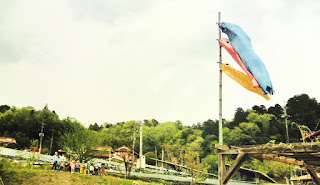In Japan, cultural practices have surrounded rice
cultivation since ancient times. Various seasonal festivals are held to pray
for the prosperity of the people, and for the community to grow strong like the
rice plants. These are times to express gratitude and indebtedness toward the
gods of nature, whom we have been living in close proximity with. We at Sakura
help children in building foundations for their lives and minds (both of which
are connected to nature) by celebrating these traditional Japanese customs. Consistently celebrating the turning
points of the four seasons allows children to internalize the rhythms of the
year.
April
Kindergarten entrance ceremony
Originally, cherry blossom viewing was a seasonal
event during which people ate and drank, appreciating the beauty of flowers
together with the god of the mountain. People delight in the coming of Spring,
and express their gratitude for the season. They pick flowers as a symbol of
the coming Spring, and place them at the entrances to their houses and rice
fields, wishing for a rich harvest in the fall. SAKURA takes children into the
woods to look for and pick spring flowers. Children make cherry-flavored rice
cakes, enjoying them under the cherry trees in the yard while they appreciate
the flowers.
MAY
Children’s Day
May
brings in the season of vitality and freshness, and is the period right before
rice planting. In this season, families celebrate children’s healthy growth and
wish for them to have vital energy. At Sakura, we put up colorful, handmade
carp streamers on a pole in the yard. Children make and eat rice cakes wrapped
in oak leaves, and take foot baths into which iris leaves are placed. It has
been said that bathing with iris leaves prevents one from catching cold or
succumbing to evil spirits. This tradition originates from the ancient Japanese
custom of purifying one’s body with iris leaves and eliminating evil spirits
before rice planting.
Rice Planting
Children
go into a muddy rice field, and plant seedlings carefully one by one. They feel
how much effort is involved in planting the seedlings that will produce
delicious rice, and they experience how difficult it is to walk in a paddy
field. Our aim is for them to experience the foundations of Japanese culture
through rice cultivation.
JUNE
Summer purification ceremony
The
summer purification ceremony is an event held to expel any impurities
accumulated in the human body during the first half of the year, and to pray
for health during the remainder of the year. Children pass three times through
a big hoop made of bamboo grass, tracing the shape of the number 8. Children
also make and eat minazuki (a
traditional Japanese confectionary, triangular in shape and resembling ice) in
order to overcome the summer heat.
JULY
The Star Festival
The
star festival is a seasonal event originating from both ancient Chinese legends
and Japanese mythology. As the Chinese legend says, the Herdsman and the Weaver
(also known as the stars Altair and Vega) had been forced to separate. They
were allowed to meet only once a year, over the Milky Way, on the night of July
7. In another vein, the Japanese mythology says that the Weaver Tanabata-tsume, a pure maiden, had woven
a sacred fabric as an offering to the spirits. These varying legends and
mythologies merged. On this day, people wish upon a star and decorate bamboo
with origami paper folded into an assortment of shapes. The bamboo is also
covered with various colored paper strips, on which people write short
sentences containing wishes. It has been said that a wish will come true if it
is written in calligraphy ink made with morning dew. At SAKURA, on this day,
children collect morning dew in the yard, and write wishes on the strips with
the ink. They then hang the strips with their wishes, and beautiful hand-made
origami decorations, over bamboo branches. The next day, we burn the strips of
paper and deliver our wishes to the stars.
S
Summer
is the season when the four elements (water, earth, wind and fire) are the most
vital. SAKURA has a summer festival to celebrate the lively and energetic
atmosphere of nature, and to appreciate its power. At the end of the festival,
children ignite lanterns (which they have made from scratch), carrying them as
they walk the path toward home.
SEPTEMBER
Rice Harvest
When
the rice plants have grown well, children gratefully reap every bunch using a
sickle. They vigorously harvest the rice, binding big bunches with rice straws,
and then hang them on a bar to dry. The fully-grown rice, which the children
planted in May, allows them to experience the pleasure of harvesting. Children
participate in the complete process of rice production, and come to understand
the Japanese rice harvesting culture passed down from ancient times.
In
olden times, on the day of the full moon in Autumn, a festive ritual was held
to consecrate the first ears of rice to Gods. These days, moon viewing is an
event during which people appreciate the beauty of the moon. The moon’s
connection to the growth of rice and vegetables is celebrated, and people
express appreciation for the rich harvest. They offer rice dumplings made with
the newly- harvested rice flour and fresh vegetables. People traditionally
share food, and let their children select and eat foods of their choosing. This
custom is meant to express the importance of being selfless and considerate
toward others. At SAKURA, we celebrate the event by watching a circle time
performance by the children, and a puppet show presented by the teachers. We
then go to the yard and, under the full moon, eat rice dumplings made by the
children. A family shares one plate of dumplings.








